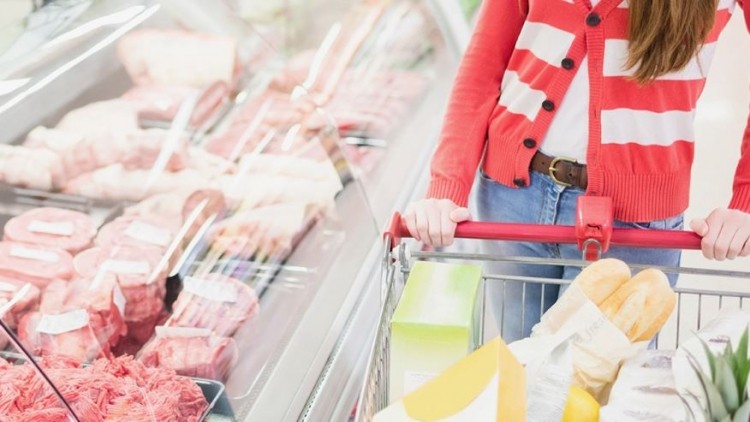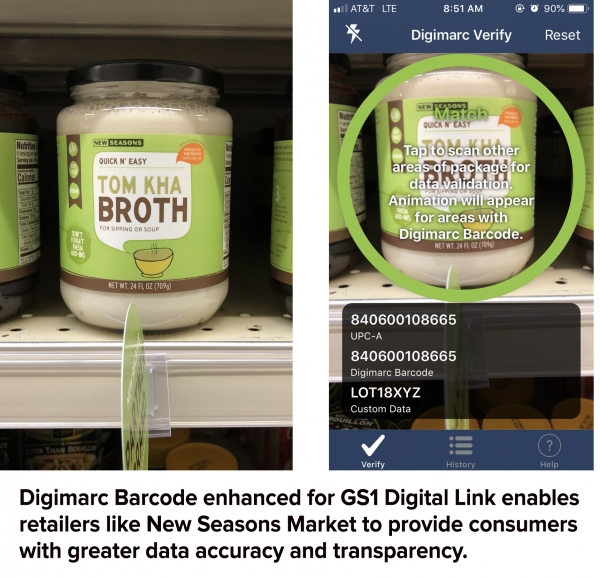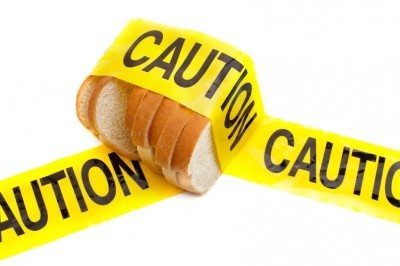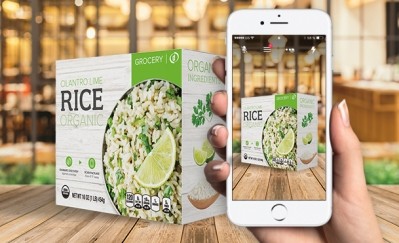Digimarc: ‘Adding the GS1 Digital Link creates greater transparency & brand loyalty’

As businesses begin to deploy technology leveraging the standard, FoodNavigator goes behind the scenes to understand how brands and retailers can enhance their content including product images, expiration dates, nutritional data, warranty registration and traceability.
Pilot projects
For supply chains, GS1 Digital Link can also provide safety information on the transport or disposal of a product and photographic evidence of a product’s chain of custody to prove authenticity.
For those ‘not-in-the-know’, the digital link is a digitally-enabled, globally-unique identifier resembling a Uniform Resource Locator (URL) or Web address.
Announced in late summer 2018, the link specifies a standard format for a web URL, GS1 GTIN (Global Trade Item Number) and several GS1 application identifiers into one single URI with a standardised syntax.
It can be included in barcodes and QR codes for example, allowing consumers to connect directly to brand-authorised product information via the product packaging.
Pilot projects are already underway, as technology providers and brand owners join forces to upgrade their platforms to support the new standard.
“Accurate product data and information transparency are critical to informing today’s purchase decisions,” said Carrie Wilkie, senior VP, standards development, GS1 US (GS1 global, is a not-for-profit organisation that promotes industry collaboration to improve supply chain visibility and efficiency through GS1 Standards).
“By leveraging GS1 Digital Link, any product can now be automatically connected to the Web and represented in a clear, accurate, consistent format that promotes brand, retailer, and consumer interaction, including robust product engagement opportunities.”
We speak to Heidi Dethloff, VP, marketing, Digimarc, which has incorporated the GS1 digital link into its barcode, including detection at point-of-sale from barcode scanner devices.
“In January, Digimarc announced Digimarc Barcode was accepted by the USDA as an approved digital disclosure method for the National Bioengineered Food Disclosure Standard that went into effect in the US on February 19, which requires packaging to disclose if there are GMOs present in the food product,” said Dethloff.
“This adds to the capabilities for Digimarc Barcode which is already an approved carrier for SmartLabel.
Product transparency
“Digimarc announced its support of SmartLabel in May 2018, to provide a more reliable, efficient and flexible way to provide product transparency.
“The SmartLabel program was developed by the Grocery Manufacturers Association (GMA) and the Food Marketing Institute to give consumers a way to digitally access more detailed product information than could fit on a package.
“The free SmartLabel app incorporates the Digimarc Mobile SDK, providing the ability to scan product packages enhanced with Digimarc Barcode.”
Dethloff added that the code is nearly invisible to the naked eye though readable by smartphone cameras and POS scanners. Unlike visible barcodes, it is difficult to copy or alter, and Digimarc Barcode is applied during the artwork process repeating data across the entire package art making it more reliable and data redundant.
Digimarc has a long history of collaboration with GS1 and participates in its GS1 Digital Link Working Group.
“GS1 Digital Link Working Group brings users from industries around the world to develop and implement supply chain standards,” said Dethloff.
“The group works together to develop industry-wide standards, guidelines and technologies. Digimarc is participating in a GS1 technical working group regarding compression algorithms, and we plan to engage in the implementation effort in the future.
“We are watching, learning and helping to shape the implementation across the industry and provide guidance based on our experience in encoding data.”
Wegmans Food Markets and New Seasons Grocery are two early adopters who are building their product inventory with Digimarc Barcode enhanced packaging.
New Seasons Market, in Seattle, a West Coast independent grocer, is deploying Digimarc Barcode for its packaging and thermal labels for a faster, more accurate checkout.
It now has the ability to encode the GTIN, plus the lot number and other standard identifiers.
“GS1 aspires to create a path for two-dimensional (2D) codes to reduce the need for multiple codes on packs,” added Dethloff.
“Multiple codes on packs can cause confusion and complication across supply chain, mobile scanning and point-of-sale experiences.
“Without a common standard for communicating this information, various organisations and companies will likely continue to use isolated methods that may limit global interaction, which can lead to problems of visibility across sectors and affect food safety.
Link from HP
“Digimarc recently collaborated with Link from HP, a serialised package printing technology that has better capabilities for tracking and traceability purposes. Each item has a personalised serialisation code, meaning any mass recall can be traced back to the source nearly instantly so any other contaminated items can be identified and removed from the shelves.”
Assigning SGTINs (Serialised Global Trade Item Number) to individual items means two otherwise identical units of the same product are uniquely identifiable, making it possible to track and trace for brand protection and product origination.
By monitoring scanning behaviour and tracking data, the HP Link platform automatically identifies suspicious behaviour, including diverted packages. Cloud-based product and tracking information can be applied throughout the supply chain through to the end consumer.
“Traceability initiatives are being fuelled by product fraud, recalls, regulatory compliance and the need for greater transparency across the supply chain,” said Dethloff.
“This digital capability from HP allows brands to free-up their package design real estate, while leveraging the full benefits of variable data printing for connected, customised, personalised and serialised packages.”
Dethloff added Digimarc is focused on consumer packaged goods and retailing but is actively exploring other opportunities such as identification of plastics to help recycling initiatives.
Additionally, the technology can be adapted for other mediums such as music where there are additional possibilities for copyright protection.
“The Digimarc Intuitive Computing Platform (ICP) is a comprehensive set of technologies for identifying, discovering and interacting with digitally-enhanced media and objects,” she said.
“It is the underlying technology for Digimarc Barcode and the Barcode of Everything, meaning ICP can be widely applied to objects beyond packaged goods. A near-term opportunity is identification of plastics to aid in recycling initiatives.
“Digimarc Barcode now can provide web connections for consumers according to the standard and also be leveraged for product transparency initiatives, including SmartLabel and the recently adopted Bioengineered Food Standard for disclosing GMOs.”
GS1 TIMELINE
- 1973: The barcode standard is agreed
Industry leaders in the US select a single standard for product identification. Still used today, it’s known as the GS1 barcode.
- 1974: The first barcode is scanned
On April 26, a packet of chewing gum becomes the first barcoded product to be scanned in a supermarket.
- 1977: The GS1 system is launched
The European Article Numbering (EAN) Association (later called GS1) opens an office in Brussels. Its founding members launch an identification system to improve supply chain efficiency.
- 1983: Barcodes are used on wholesale multipacks
As barcodes have proved their reliability and usefulness in real-world environments, they are extended and used on product outer cases.
- 1989: GS1 moves beyond barcodes
With wide area networks making an impact on supply chains, we create our first international standard for electronic data interchange.
- 1990: Responsibilities grow
The US and international arms of GS1 come together formally, creating a single organisation with a presence in 45 countries.
- 1999: The GS1 DataBar arrives
After significant R&D, the GS1 DataBar is created. This holds more information than a barcode, yet is significantly smaller.
- 2000: 90th local office opens
In 10 years, we double the number of countries in which we have a local presence.
- 2002: Global standards forum launched
Our Global Standards Management Process is launched. This global forum gives GS1 members one place to discuss standards.
- 2004: The first standard for RFID is created
With Radio Frequency Identification (RFID) Chips becoming more common, we create a standard for their implementation and use.
- 2007: GS1 enters the business-to-consumer world
As ecommerce grows, we begin to create open standards that give consumers direct access to key product information.
- 2013: A 40-year celebration
With a presence in over 100 countries and more than a million members, we celebrate 40 years of the global language of business.





























